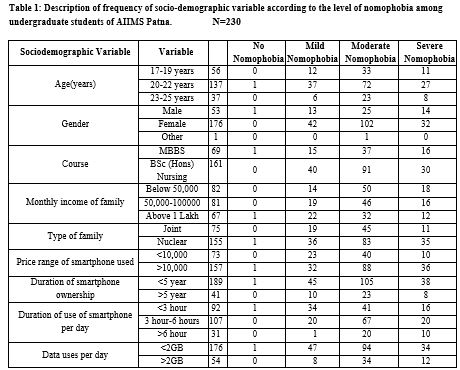Prevalence and associated factors of nomophobia among undergraduate students of AIIMS Patna
Abstract
Introduction: In recent years, the popularity of smartphones has grown to the point that it is unimaginable for individuals to do anything without using one. Nomophobia is the fear of being cut off from one's mobile phone, and it relates to the discomfort, anxiety, tension, uneasiness, and anguish that comes with it. Since the first decade of the twenty-first century, when this social phobia was coined, a growing number of research have investigated and reported the prevalence of this technology-related condition. This study aims to assess the prevalence and associated factors of nomophobia and to determine association of prevalence and associated factors of nomophobia with selected socio demographic variables among undergraduate students of AIIMS Patna. Material and Methods: The research approach here is quantitative approach and the design used here is descriptive. Undergraduate students of AIIMS, Patna are taken as target population in which minimum required sample size was 210 but it was increased to 230 for this study. Data was collected by sending questionnaire via social media. Data analysis was done by using descriptive and inferential statistics. Results: It shows that out of the taken 230 samples, total 229(99.56%) are having nomophobia in which 55(23.913%) are having mild nomophobia, 128(55.652) are having moderate nomophobia, 46(20%) are having severe nomophobia i.e. most of the students are moderately nomophobia. The findings also reveal that there is association of prevalence and associated factors of nomophobia with selected socio demographic variables (Duration of using smartphone per day) with p value 0.000 and the Fisher exact value is 22.169 by using SPSS, the p value for this study is 0.05. Conclusion: The study shows that 99.56% of students are having nomophobia and it is an alarming wake up.
Downloads
References
2. Veerapu N, Philip RKB, Vasireddy H, Gurrala S, Kanna ST. A study on nomophobia and its correlation with sleeping difficulty and anxiety among medical students in a medical college, Telangana. Int J Community Med Public Health [Internet]. 2019 Nov 5 [cited 2021 Sep 8];6. Available from: https://www.ijcmph.com/index.php/ijcmph/article/view/4479
3. Yildirim C, Correos AP. Exploring the dimensions of nomophobia. 2015 Aug [cited 2021 Sep 8];49:132-137. Available from:https://www.researchgate.net/publication/273705474_Exploring_the_dimensions_of_nomophobia_Development_and_validation_of_a_self-reported_questionnaire
4. Leon-Mejia AC, Gutierrez-Ortega M, Serrano-Pintado I, Gonzalez-Cabrera J. A systematic review of nomophobia prevalence. PLOS ONE [Internet]. 2021 May 18 [cited 2021 Aug 31];16(5):e0250509. doi:10.1371/journal.pone.0250509. Available from: https://journals.plos.org/plosone/article?id=10.1371/journal.pone.0250509
5. Kung V. Rise of nomophobia: More people fear loss of mobile contact. CNN Business [Internet]. 2021 Mar 7 [cited 2021 Sep 9]. Available from: https://edition.cnn.com/2012/03/06/tech/mobile/nomophobia-mobile-addiction/index.html#:~:text=According%20to%20the%20survey%2C%20the,%E2%80%93%20those%20aged%2025%2D34
6. Yildrim C, Correia AP. Understanding nomophobia. ResearchGate [Internet]. 2015 Aug [cited 2021 Sep 11];68:724-735. Available from: https://www.researchgate.net/publication/300644351_Understanding_Nomophobia_A_Modern_Age_Phobia_Among_College_Students
7. Asok AS. Nomophobia: Fear of being without a mobile phone. J Community Health Manag [Internet]. [date unknown] [cited 2023 Jun 12]. Available from: https://www.jchm.in/html-article/12808#.YTsv7B-fUZk.whatsapp
8. Poyrazgurson. Importance of mobile phones [Internet]. [cited 2014]. Available from: [source not found]García-Montes. 10 ways cell phones help people living in poverty [Internet]. 2012 [cited 2014]. Available from: [source not found]
9. Hought. Psychological influences of mobile phone use amongst Australian youth [Internet]. 2011 [cited 2014];2007 [updated 2012 Feb 29]. Available from: [source not found]
10. Yildrim C, Correia AP. Exploring the dimension of nomophobia: Development and validation of a self-reported questionnaire. Comput Human Behav. 2015;49:130-137. Available from: [source not found]
11. Ganesh Shanmugasundaram A, Anusuya G, et al. A cross-sectional study on nomophobia among undergraduate medical students in Chennai, India. J Clin Diagn Res. 2021 Dec;15(12):12. Available from: [source not found]
12. Madhusudan M, et al. Nomophobia and its determinants among the students of medical college in Kerala. Int J Med Sci Public Health. 2017;6(6):1046-1049. Available from: [source not found]
13. Pavithra MB, et al. A study on nomophobia - mobile phone dependence among students of medical college in Bangalore. Natl J Community Med. 2015;6(3):340-344. Available from: [source not found]
14. Soumitra Sethia, et al. A study to assess the degree of nomophobia among the undergraduate students of medical college in Bhopal. Int J Community Med Public Health. 2018;5(6):2442. Available from: [source not found]
15. Janki Bartwal, et al. Evaluation of nomophobia among medical students using smartphones in North India. Med J Armed Forces India. 2020;76(4):413-418. Available from: [source not found]
16. Mohammed Qutishat, et al. University students' nomophobia prevalence, socio-demographic factors, and relationships with academic performance at a university in Oman. Int J Africa Nurs Sci. 2020;13:100202. Available from: [source not found]
17. Haka MS, Sahaeen HM, et al. Nomophobia among medical residents. Med J Cairo Univ. 2020;88(3):1094-1100. Available from: [source not found]
18. Surekha V, et al. Prevalence of nomophobia and its association with stress, anxiety, and depression among students. Biomedicine. 2020;40(4):522-525.

Copyright (c) 2023 Author (s). Published by Siddharth Health Research and Social Welfare Society

This work is licensed under a Creative Commons Attribution 4.0 International License.


 OAI - Open Archives Initiative
OAI - Open Archives Initiative


